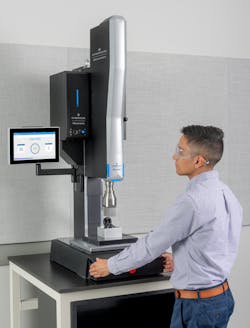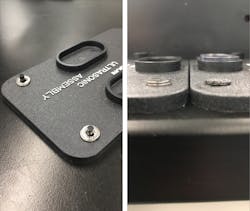New Ultrasonic Welder Mode Uses Real-time Adjustments to Improve Welds
Traditional ultrasonic plastic welding “modes” use computerized measurements associated with each weld to control weld consistency by focusing on a single parameter or a limit most critical to part quality such as downforce, distance/collapse depth, time, or energy. For typical rigid, plastic parts, these weld modes help ensure high repeatability and quality for welding, insertion, staking and swaging operations.
However, controlling weld quality with single-parameter welding has made choosing a weld mode much more difficult when assembling plastic parts that:
- Are compressible or contain compressible elements.
- Are inserted into substrates that vary in hardness or structural consistency.
- Contain or are installed over sensitive metal or electronic components that could be damaged by pressure, vibration, or heat during ultrasonic welding essential for product assembly.
To ensure consistent assembly quality with such “hard-to-handle” or variable parts, electronics manufacturers and others have had to augment single-parameter weld-modes with additional information. Generally, this is done by adding a measuring device external to the welder that provides a data point or signal that allows for changes in the critical weld parameter.
The practice of adding external measurement devices and associated input/output (I/O) to an ultrasonic welder is not uncommon. However, it does add time, complexity, and expense to the process, particularly for mass-produced parts, and adds a new wrinkle to the customer/technical support relationship.
Engineers in the ultrasonic-welding industry thought the added trouble of adding sensors raised some questions: What would it take to build a welder that would not need external measuring devices? How could this be done? What kind of hardware, software or weld modes would it take?
A group at Emerson sought out the answers. Building on the latest Branson ultrasonic plastic welding machine, the team developed a patent-pending “dynamic mode” and introduced it on the Elite Precision+ version of the GSX-E1 welding machine.
The new mode takes advantage of several key GSX-E1 features, including an advanced electromechanical weld actuator, new ultrasonic welding algorithms, high-speed data communications and a big boost in computing power. Its upgraded software supports more robust automation and faster actuator response when interfacing with PLCs and gives users more flexibility in developing and deleting application-specific welding recipes.
The improvements let the new dynamic mode overcome the limitations of single-parameter weld mode controls. It can monitor, recalculate, and adjust several weld parameters such as force, weld energy, velocity, and distance in real time. This enables optimization of weld performance in terms of a user-specified target value such as part compression, positioning, or pull strength. In essence, the new mode gives users greater versatility and more consistent welding results that match a design profile rather than just a single parameter.
To use a welder equipped with dynamic mode, operators select the single-parameter weld mode that provides the best application results to date. Then, they enter two application-specific “scores,” which act as limits for dynamic mode activity. The first is a material “density” score that characterizes the hardness or resistance of the material that is to receive the welded, staked, or inserted part. Low density scores equate to harder, more resistant materials. The second, the “reactivity” score, affects the reaction time needed to get the desired density setting.
In operation, dynamic mode monitors each weld cycle, using the density and reactivity limits to adjust and improve the cycle in response to specific part-to-part variabilities throughout the production run.
Dynamic Mode Ultrasonic Welding in Action
To get a sense of how dynamic mode works, and how it overcomes the limitations of single-parameter weld-mode controls for hard-to-handle parts, consider a few application examples.
Sealing a watertight cover atop electronics. The challenge was to weld a form-fitting, watertight plastic cover onto the shell of a small electronic device. The cover is closely contoured to fit around sensitive electronic components and complete the device’s protective structural shell. The plastic cover must be bonded gap-free and watertight, but the weld process and cover structure cannot touch or compress the electronics beneath. Due to ordinary part variability, relying on a single-parameter weld mode (e.g., weld distance/collapse depth) could put too much pressure on the cover and could damage the electronics.
With the help of material density and reactivity scores, the dynamic welding mode improves the distance/collapse depth mode in each weld cycle. It lets the weld actuator achieve part collapse depth sufficient for watertight sealing, while detecting and avoiding higher levels of resistance that equate with compression of the electronics below the welded cover.
Welding a sealed, elastomer-core pin connector. The challenge in this case was to assemble an elastomer-filled, two-way pin connector with dimensional consistency. The connector’s outer shell was a molded plastic cup and lid with holes through which metal connecting pins protruded. Inside, connecting pins are embedded in a compressible core of elastomeric plastic. Because the finished plugs must be air- and water-tight, the weld-on lid is designed to compress the elastomer radially around the connecting pins.
A flat “fit” is essential for the lid, as it determines the pins’ exposed sections, which should be consistent. However, the height of the plug’s elastomeric core can vary by up to 10%, so achieving consistent positioning and shell contact, as well as finished weld quality for the lid, is difficult. Using a single-parameter weld mode on this compressible assembly risks creating unacceptable variances in lid height and the exposed lengths of connecting pins, and could compromise the watertight seal.
The density score used in the dynamic weld mode overcomes this challenge by allowing weld-by-weld adjustments that compensates for the varied consistency and height of the plug’s core. The new mode requires not only that the actuator travel the required distance, but also that it “feels” the specified amount of resistance (e.g., contact with the harder material on the plug’s rim) before starting the essential lid weld.
Inserting structural pins into a substrate. The final challenge was to insert structural plastic pins into plastic substrates (i.e., wood/plastic composites) that vary in hardness while keeping insertion depth and pull strength consistent. The structural pins fit into grooves needed to assemble the larger product. The pins must provide consistent strength despite variability in the hardness of surrounding material, depth and diameter of drilled holes, and their own molded quality (e.g., surface roughness, flash).
Using a single-parameter weld mode to deliver identical force/energy for each insert could result in over-insertion and substrate, insert damage or under-insertion, misalignment, and pull-out.
Augmenting energy mode with material density and reactivity scores available in dynamic mode lets welders measure and moderate the input of weld energy for each insert, aiming for a target condition—a uniform measure of insert resistance—that equates with insert pull strength.
Ultrasonic welding, including the single-parameter weld modes, let electronics manufacturers meet high levels of assembly quality, especially for products built from rigid, molded plastic components. But companies that assemble products from components with more dimensional, flexural, or material-related variability have faced a tougher challenge, one typically met by in-house modifications to ultrasonic welding equipment.
For these manufacturers, as well as those facing next-generation assembly challenges—miniaturization, lighter, thinner plastic parts, closer assembly tolerances, flexible or compressible components, higher electronics content and hermetic sealing requirements— a new range of assembly innovations, such as this new dynamic mode for ultrasonic welding, will likely to shape the future of electronic product assembly.
With that in mind, manufacturers should not be redesigning hard-to-assemble parts or augmenting weld processes with new measurement or sensing devices. Instead, they should be asking their assembly-technology supplier for ideas and suggestions. Thanks to the exceptional pace of innovation throughout the ultrasonics industry, a solution to your assembly problem may already be out there.
Tarick Walton is global product manager for ultrasonics at Branson Welding and Assembly/Emerson.
About the Author
Tarick Walton
Global Product Manager of Ultrasonics, Branson
Tarick Walton is global product manager of ultrasonics for Branson Welding and Assembly at Emerson and led the company’s launch of the Branson GSX Ultrasonic Welding Platform. He also provides strategic support for performance and quality assurance across the Branson ultrasonic portfolio. Walton holds a bachelor’s degree from MIT and an MBA from Georgetown University.


